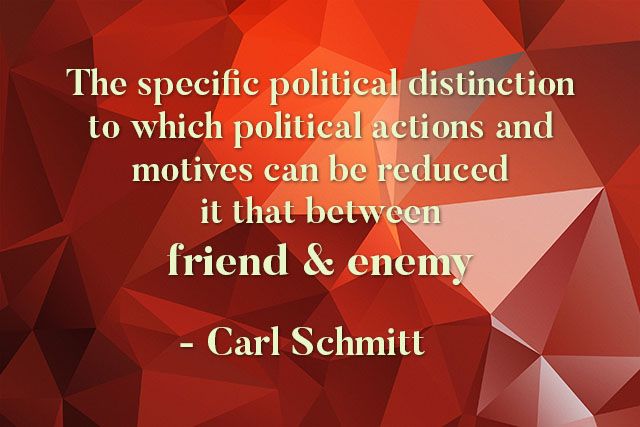Friend-Enemy Distinction
Carl Schmitt's concept is that the essence of politics can be found in the distinction between friends and enemies.

Executive Summary
Carl Schmitt: The Friend-Enemy Distinction - YouTube
Carl Schmitt's concept is that the essence of politics can be found in the distinction between friends and enemies.
Steel-manning the Idea
The Friend-Enemy distinction is a concept that originated from political philosopher Carl Schmitt in his work "The Concept of the Political" (1932). According to Schmitt, the essence of politics lies in the distinction between friends and enemies.
In Schmitt's view, the political realm is defined by the presence of an existential conflict between groups or nations. Hence his argument that the fundamental characteristic of politics is the division of humanity into friend and enemy.
- The friend represents one's own group, community, or nation
- The enemy represents the opposing group or community with conflicting interests and values.
The friend-enemy distinction is not merely based on superficial personal likes or dislikes but rather on a deep-seated antagonism between groups, rooted in irreconcilable conflicts of interest and values. A key here is that he believed that the political domain is ultimately defined by the possibility of an actual violent confrontation between rival groups.
According to Schmitt, the friend-enemy distinction is crucial because it helps define the political identity of a group and shapes its actions and strategies. In times of political crisis or conflict, individuals and groups are forced to align themselves either with friends or enemies. This distinction serves as a rallying point for collective identity and mobilization.
4 ways the friend-enemy distinction contributes to the formation of a political identity:
Collective Identity: The clarification of friends & enemies creates a sense of solidarity and belonging among individuals of a group. This process helps them determine who belongs to their own community or nation (the friends), and they can develop a shared sense of identity, values, and interests. This collective identity creates the basis for group cohesion, cooperation, and collective action.
Differentiation & Othering: The friend-enemy distinction helps differentiate one's own group from others. It establishes a sense of opposition and contrast, emphasizing the differences and conflicting interests between the in-group (friends) and the out-group (enemies). This process of differentiation and othering strengthens the group's identity by reinforcing a sense of uniqueness, common purpose, and a shared narrative of who they are in relation to the enemy.
Mobilization & Conflict: The identification of enemies can mobilize a group and galvanize its members into action. Perceiving a threat from the enemy, the group may unite and rally around a common cause, fostering a heightened sense of political identity. This mobilization often involves the construction of an enemy image or a narrative that justifies the need for collective action, be it political, social, or even military.
Definition of Interests & Values: The friend-enemy distinction clarifies which interests, values & goals are aligned with the friend-group vs the out-group and thus helps shape the political agenda of the group. This also becomes a guiding framework for political decision-making, policy formulation, and the pursuit of specific objectives.
Straw-manning the Idea
While the friend-enemy distinction plays a role in defining political identity, it can also have negative consequences.
- Critics argue that reducing politics to the identification of enemies can lead to an overly simplistic and dangerous worldview, undermining pluralism and peaceful coexistence.
- It can lead to exclusion, animosity, and the perpetuation of conflict, potentially hindering cooperation, dialogue, and understanding between different groups. The manner in which the distinction is employed and interpreted greatly influences its impact on political dynamics and relationships.
The political Left tend to be very solid in their conceptualization of friends vs enemies, while the Right tend to be weak in this area, leading to confusion and lack of cohesion in their ranks. This lack of proficiency has also caused those on the Right to be "othered" by the Cathedral and in general society for their beliefs.
Major Thinkers and Works
- Carl Schmitt
- The Concept of the Political (1932)
Quotes:
- "The specific political distinction to which political actions and motives can be reduced is that between friend and enemy" - Carl Schmitt
Tags:
#idea #nrx